From conception to birth: A look at the stages of pregnancy

Fox News Flash top headlines for December 3
Fox News Flash top headlines are here. Check out what’s clicking on Foxnews.com.
How does a baby develop inside the womb? Fox News looks at the various stages of development from conception to birth.
Pregnancy tends to follow a well-understood and predictable course. But according to experts at Cleveland Clinic and the Mayo Clinic, many are surprised to learn that the start of pregnancy is about two weeks ahead of when conception actually occurs. The first day of a female’s last menstrual period is when pregnancy is considered to begin. This is referred to as the gestational age, or menstrual age, and is calculated into the pregnancy length and due date, according to both health systems’ websites.
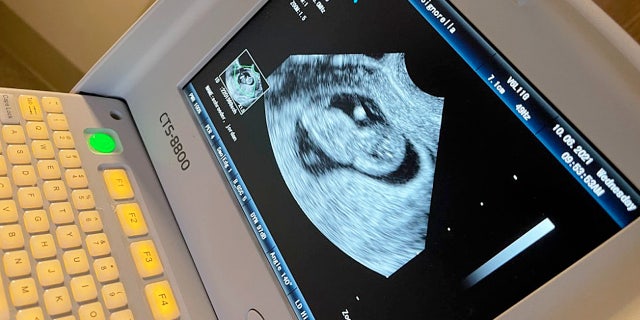
(Fox News Digital)
According to the Mayo Clinic, “Conception typically occurs about two weeks after your last period begins. To calculate your estimated due date, your health care provider will count ahead 40 weeks from the start of your last period. This means your period is counted as part of your pregnancy — even though you weren’t pregnant at the time.”
For this reason, we will define the timeline of the stages of development referring from the time of conception to avoid confusion.
According to the health experts at both the Cleveland Clinic and Mayo Clinic, the following development occurs from the time of conception:
First Trimester:
The first trimester of development of the baby is considered to span from conception to 12 weeks, according to health experts.
Conception through Week 1:
The egg begins to rapidly divide into many cells within 24 hours of fertilization. It is referred to as a blastocyst and typically stays in the fallopian tubes of the female for three days. The fertilized egg continues dividing and then moves and implants onto the female’s uterus.
- Image 1 of 7
(iStock)
- Image 2 of 7
(iStock)
- Image 3 of 7
(iStock)
- Image 4 of 7
(iStock)
- Image 5 of 7
(iStock)
- Image 6 of 7
(iStock)
- Image 7 of 7
(iStock)
Week 2 to Week 4 post conception:
Within three weeks, the fertilized egg forms a little ball and is referred to as an embryo. By this time, the first nerve cells have formed, according to the Cleveland Clinic. The embryo now consists of three layers that will lead to development of several of the baby’s systems and organs.
According to the Mayo Clinic, four weeks after conception, the neural tube is closing. The baby’s brain and spinal cord will develop from the neural tube. The heart and other organs start to form. Small buds appear that will form arms and the eyes and ears begin to develop. The embryo is about ¼ inch long and takes on a C-shaped curve shape.
The tiny “heart” tube will beat 65 times a minute by the end of the fourth week, according to the Cleveland Clinic.

(iStock)
5 weeks post conception:
According to the Mayo Clinic, five weeks after conception, your baby’s brain and face are growing. Depressions are seen that help form nostrils and the retinas of the eyes begin to form. The arm buds now sprout into paddles and lower limb buds begin to form. The brain and face begin to grow.
6 weeks post conception
At the conclusion of 6 weeks, the baby can grow to half the diameter of a U.S. quarter, according to the Mayo Clinic. While the upper lip and nose have formed, the buds of the lower limb now begin to look like paddles. Fingers begin to form and the outline of the ears develop while the eyes become more apparent.
7 weeks post conception
According to the health experts at Mayo Clinic, at seven weeks after conception, the embryo’s arms and elbows grow as toes and eyelids form.
8 weeks post conception
After the 8th week, the embryo is called a fetus until it is born. The eyelids and ears develop and the umbilical cord is seen. Toes and fingers grow longer and the fetus can bend and move its elbows.
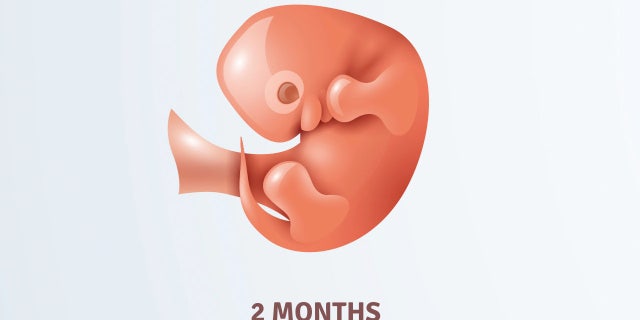
(iStock)
Weeks 9 to 12 post conception
Health experts say that at this point the baby is now officially called a fetus. Red blood cells begin to form in the fetus’ liver, the external genitalia begin to develop, and the intestines are in the abdomen according to the Mayo Clinic.
The Cleveland Clinic says that at this stage, the fetus starts opening and closing its fists and mouth. The arms, hands, fingers, feet, and toes are fully formed and fingernails and toenails are starting to develop while the outer ears are formed.
By the end of this first trimester, the Cleveland Clinic says all the organs, arms and legs are present, the circulatory and urinary systems work and the liver produces bile. The health system says the fetus is fully formed and is typically 4 inches long, weighing about an ounce. At this stage the Cleveland Clinic says the most critical development has taken place and risk of miscarriage drops significantly after the first three months.

(iStock)
Second Trimester:
(Months 4 – 6)
This middle stage of the pregnancy is when the mother can start to feel movement of the fetus. The parents can also find out whether their child will be designated a male or female, according to the Cleveland Clinic.
Month 4 (weeks 13 through 16)
The fetus’ heartbeat can be heard through a Doppler and the fetus can yawn, suck its thumb, and make faces, according to experts at the Cleveland Clinic.
By the end of the fourth month, the fetus can be 6 inches long and its nervous system begins to function. The genitalia and reproductive organs and genitalia are fully developed so parents and physicians can detect the sex of the fetus through ultrasound, according to health experts.
Month 5 (weeks 17 – 20)
At this stage, the fetus begins to develop its muscles. The mother can often feel the fetus moving. Hair also begins to grow, according to the Cleveland Clinic.
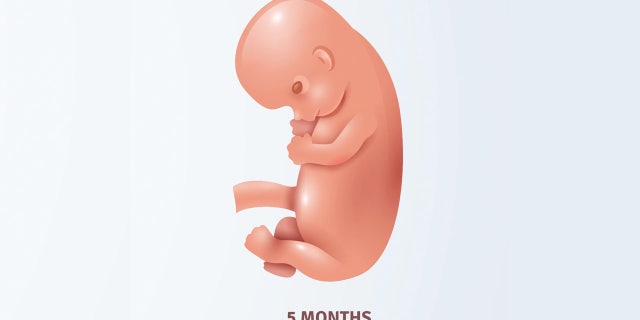
(iStock)
Month 6 (weeks 21- 24)
Experts at the Cleveland Clinic say that the eyes begin to open, and the fetus can respond to a noise through movement or increased pulse at this stage. The fetus can even hiccup. If the fetus is born prematurely after the 23rd week, with intensive care treatment it may be able to survive, according to the Cleveland Clinic. By now, the fetus is about 12 inches long and can weigh up to two pounds.
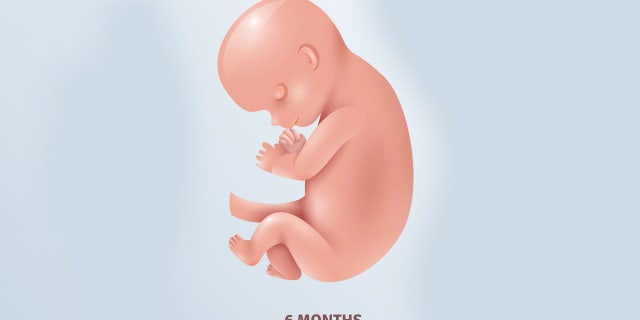
(iStock)
Month 7 (Week 25 – 28)
According to experts, the fetus’ hearing is fully developed during this stage. It can respond to certain stimuli including sound, pain and light. The fetus is now almost four pounds and will often change positions, the Cleveland Clinic says.
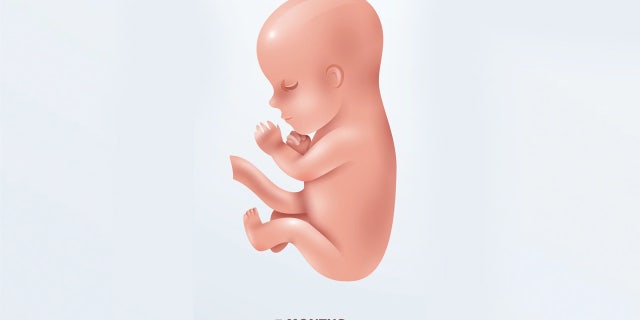
(iStock)
Month 8 (Weeks 29 – 32)
The mother may notice the fetus, which is now about 5 pounds and 18 inches in length, kicks more during this month. The brain of the fetus is developing rapidly, and the fetus can see and hear, according to the Cleveland Clinic. While most of the systems have developed, the lungs are often still immature.
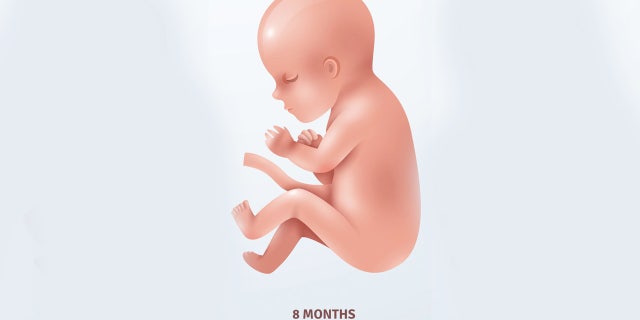
(iStock)
Month 9 (Weeks 33 through 36)
The fetus continues to grow in length and has coordinated reflexes. It can turn its head, grasp, close the eyes, and blink and respond to light, touch and sound, according to the Cleveland Clinic.
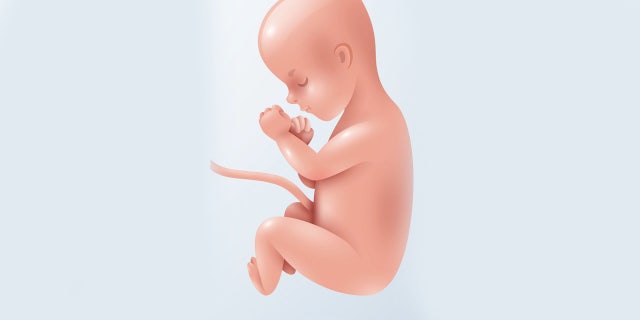
(iStock)
Month 10 (Weeks 37 through 40)
This final month the fetus is preparing for birth. It can be up to 20 inches and weight approximately 7 pounds. Because space is tight, less movement may be felt, the Cleveland Clinic says.
Source: Read Full Article



